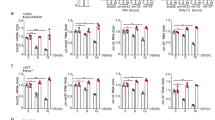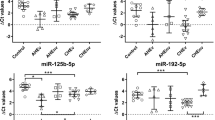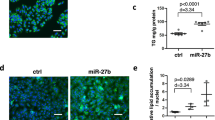Abstract
Immune regulation of cellular metabolism can be responsible for successful responses to invading pathogens. Viruses alter their hosts' cellular metabolism to facilitate infection. Conversely, the innate antiviral responses of mammalian cells target these metabolic pathways to restrict viral propagation. We identified miR-130b and miR-185 as hepatic microRNAs (miRNAs) whose expression is stimulated by 25-hydroxycholesterol (25-HC), an antiviral oxysterol secreted by interferon-stimulated macrophages and dendritic cells, during hepatitis C virus (HCV) infection. However, 25-HC only directly stimulated miR-185 expression, whereas HCV regulated miR-130b expression. Independently, miR-130b and miR-185 inhibited HCV infection. In particular, miR-185 significantly restricted host metabolic pathways crucial to the HCV life cycle. Interestingly, HCV infection decreased miR-185 and miR-130b levels to promote lipid accumulation and counteract 25-HC's antiviral effect. Furthermore, miR-185 can inhibit other viruses through the regulation of immunometabolic pathways. These data establish these microRNAs as a key link between innate defenses and metabolism in the liver.
This is a preview of subscription content, access via your institution
Access options
Subscribe to this journal
Receive 12 print issues and online access
$259.00 per year
only $21.58 per issue
Buy this article
- Purchase on Springer Link
- Instant access to full article PDF
Prices may be subject to local taxes which are calculated during checkout





Similar content being viewed by others
References
Teissier, E. & Pécheur, E.I. Lipids as modulators of membrane fusion mediated by viral fusion proteins. Eur. Biophys. J. 36, 887–899 (2007).
Chukkapalli, V., Heaton, N.S. & Randall, G. Lipids at the interface of virus-host Interactions. Curr. Opin. Microbiol. 15, 512–518 (2012).
Miller, S. & Krijnse-Locker, J. Modification of intracellular membrane structures for virus replication. Nat. Rev. Microbiol. 6, 363–374 (2008).
Saka, H.A. & Valdivia, R. Emerging roles for lipid droplets in immunity and host-pathogen interactions. Annu. Rev. Cell Dev. Biol. 28, 411–437 (2012).
Schoggins, J.W. & Randall, G. Lipids in innate antiviral defense. Cell Host Microbe 14, 379–385 (2013).
Blanc, M. et al. The transcription factor STAT-1 couples macrophage synthesis of 25-hydroxycholesterol to the interferon antiviral response. Immunity 38, 106–118 (2013).
Liu, S.Y. et al. Interferon-inducible cholesterol-25-hydroxylase broadly inhibits viral entry by production of 25-hydroxycholesterol. Immunity 38, 92–105 (2013).
Pezacki, J.P. et al. Transcriptional profiling of the effects of 25-hydroxycholesterol on human hepatocyte metabolism and the antiviral state it conveys against the hepatitis C virus. BMC Chem. Biol. 9, 2 (2009).
Park, K. & Scott, A.L. Cholesterol 25-hydroxylase production by dendritic cells and macrophages is regulated by type I interferons. J. Leukoc. Biol. 88, 1081–1087 (2010).
Carthew, R.W. & Sontheimer, E.J. Origins and mechanisms of miRNAs and siRNAs. Cell 136, 642–655 (2009).
Friedman, R.C., Farh, K.K.H., Burge, C.B. & Bartel, D.P. Most mammalian mRNAs are conserved targets of microRNAs. Genome Res. 19, 92–105 (2009).
Rottiers, V. & Näär, A.M. MicroRNAs in metabolism and metabolic disorders. Nat. Rev. Mol. Cell Biol. 13, 239–250 (2012).
Wu, J.M., Skill, N.J. & Maluccio, M.A. Evidence of aberrant lipid metabolism in hepatitis C and hepatocellular carcinoma. HPB (Oxford) 12, 625–636 (2010).
Adams, C.M. et al. Cholesterol and 25-hydroxycholesterol inhibit activation of SREBPs by different mechanisms, both involving SCAP and Insigs. J. Biol. Chem. 279, 52772–52780 (2004).
Radhakrishnan, A., Ikeda, Y., Kwon, H.J., Brown, M.S. & Goldstein, J.L. Sterol-regulated transport of SREBPs from endoplasmic reticulum to Golgi: oxysterols block transport by binding to Insig. Proc. Natl. Acad. Sci. USA 104, 6511–6518 (2007).
Janowski, B.A., Willy, P.J., Devi, T.R., Falck, J.R. & Mangelsdorf, D.J. An oxysterol signalling pathway mediated by the nuclear receptor LXRα. Nature 383, 728–731 (1996).
Goldstein, J.L., DeBose-Boyd, R.A. & Brown, M.S. Protein sensors for membrane sterols. Cell 124, 35–46 (2006).
Su, A.I. et al. Genomic analysis of the host response to hepatitis C virus infection. Proc. Natl. Acad. Sci. USA 99, 15669–15674 (2002).
Zeng, J. et al. Liver X receptors agonists impede hepatitis C virus infection in an Idol-dependent manner. Antiviral Res. 95, 245–256 (2012).
Russell, R.S. et al. Advantages of a single-cycle production assay to study cell culture-adaptive mutations of hepatitis C virus. Proc. Natl. Acad. Sci. USA 105, 4370–4375 (2008).
Vlachos, I.S. et al. DIANA miRPath v.2.0: investigating the combinatorial effect of microRNAs in pathways. Nucleic Acids Res. 40, W498–W504 (2012).
Luna, J.M. et al. Hepatitis C virus RNA functionally sequesters miR-122. Cell 160, 1099–1110 (2015).
Qadir, X.V., Han, C., Lu, D., Zhang, J. & Wu, T. miR-185 inhibits hepatocellular carcinoma growth by targeting the DNMT1/PTEN/Akt pathway. Am. J. Pathol. 184, 2355–2364 (2014).
Xiao, F. et al. A novel function of microRNA 130a-3p in hepatic insulin sensitivity and liver steatosis. Diabetes 63, 2631–2642 (2014).
Steenbergen, R.H.G. et al. Human serum leads to differentiation of human hepatoma cells, restoration of very-low-density lipoprotein secretion, and a 1000-fold increase in HCV Japanese fulminant hepatitis type 1 titers. Hepatology 58, 1907–1917 (2013).
Alvisi, G., Madan, V. & Bartenschlager, R. Hepatitis C virus and host cell lipids: an intimate connection. RNA Biol. 8, 258–269 (2011).
Pezacki, J.P., Singaravelu, R. & Lyn, R.K. Host-virus interactions during hepatitis C virus infection: a complex and dynamic molecular biosystem. Mol. Biosyst. 6, 1131–1142 (2010).
García-Mediavilla, M.V. et al. Liver X receptor α-mediated regulation of lipogenesis by core and NS5A proteins contributes to HCV-induced liver steatosis and HCV replication. Lab. Invest. 92, 1191–1202 (2012).
Waris, G., Felmlee, D.J., Negro, F. & Siddiqui, A. Hepatitis C virus induces proteolytic cleavage of sterol regulatory element binding proteins and stimulates their phosphorylation via oxidative stress. J. Virol. 81, 8122–8130 (2007).
Pezacki, J.P. et al. Chemical contrast for imaging living systems: molecular vibrations drive CARS microscopy. Nat. Chem. Biol. 7, 137–145 (2011).
Yang, M. et al. Identification of miR-185 as a regulator of de novo cholesterol biosynthesis and low density lipoprotein uptake. J. Lipid Res. 55, 226–238 (2014).
Wang, L. et al. MicroRNAs 185, 96, and 223 repress selective high-density lipoprotein cholesterol uptake through posttranscriptional inhibition. Mol. Cell. Biol. 33, 1956–1964 (2013).
Pan, S., Yang, X., Jia, Y., Li, R. & Zhao, R. Microvesicle-shuttled miR-130b reduces Fat deposition in recipient primary cultured porcine adipocytes by inhibiting PPAR-γ expression. J. Cell. Physiol. 229, 631–639 (2014).
Hsu, P.W.C., Lin, L.Z., Hsu, S.D., Hsu, J.B.K. & Huang, H.-D. ViTa: prediction of host microRNAs targets on viruses. Nucleic Acids Res. 35, D381–D385 (2007).
Lyn, R.K. et al. Stearoyl-CoA desaturase inhibition blocks formation of hepatitis C virus-induced specialized membranes. Sci. Rep. 4, 4549 (2014).
Régeard, M., Trotard, M., Lepère, C., Gripon, P. & Le Seyec, J. Entry of pseudotyped hepatitis C virus into primary human hepatocytes depends on the scavenger class B type I receptor. J. Viral Hepat. 15, 865–870 (2008).
Catanese, M.T. et al. Different requirements for scavenger receptor class B type I in hepatitis C virus cell-free versus cell-to-cell transmission. J. Virol. 87, 8282–8293 (2013).
Li, Q., Pene, V., Krishnamurthy, S., Cha, H. & Liang, T.J. Hepatitis C virus infection activates an innate pathway involving IKK-α in lipogenesis and viral assembly. Nat. Med. 19, 722–729 (2013).
Syed, G.H. et al. Hepatitis C Virus stimulates low-density lipoprotein receptor expression to facilitate viral propagation. J. Virol. 88, 2519–2529 (2014).
Monazahian, M. et al. Low density lipoprotein receptor as a candidate receptor for hepatitis C virus. J. Med. Virol. 57, 223–229 (1999).
Takeuchi, K. & Reue, K. Biochemistry, physiology, and genetics of GPAT, AGPAT, and lipin enzymes in triglyceride synthesis. Am. J. Physiol. Endocrinol. Metab. 296, E1195–E1209 (2009).
Mercer, D.F. et al. Hepatitis C virus replication in mice with chimeric human livers. Nat. Med. 7, 927–933 (2001).
Singaravelu, R. et al. Hepatitis C virus induced up-regulation of microRNA-27: A novel mechanism for hepatic steatosis. Hepatology 59, 98–108 (2014).
Paul, D., Hoppe, S., Saher, G., Krijnse-Locker, J. & Bartenschlager, R. Morphological and biochemical characterization of the membranous hepatitis C virus replication compartment. J. Virol. 87, 10612–10627 (2013).
Sagan, S.M. et al. The influence of cholesterol and lipid metabolism on host cell structure and hepatitis C virus replication. Biochem. Cell Biol. 84, 67–79 (2006).
Li, S. et al. MicroRNA-130a inhibits HCV replication by restoring the innate immune response. J. Viral Hepat. 21, 121–128 (2014).
Lee, W.M. & Ahlquist, P. Membrane synthesis, specific lipid requirements, and localized lipid composition changes associated with a positive-strand RNA Virus RNA replication protein. J. Virol. 77, 12819–12828 (2003).
Civra, A. et al. Inhibition of pathogenic non-enveloped viruses by 25-hydroxycholesterol and 27-hydroxycholesterol. Sci. Rep. 4, 7487 (2014).
Pedersen, I.M. et al. Interferon modulation of cellular microRNAs as an antiviral mechanism. Nature 449, 919–922 (2007).
Bassendine, M.F., Sheridan, D.A., Bridge, S.H., Felmlee, D.J. & Neely, R.D.G. Lipids and HCV. Semin. Immunopathol. 35, 87–100 (2013).
Blight, K.J., Kolykhalov, A.A. & Rice, C.M. Efficient initiation of HCV RNA replication in cell culture. Science 290, 1972–1974 (2000).
Gong, E.Y., Fischl, W. & Bartenschlager, R. in Antiviral Methods and Protocols Vol. 1030, 205–219 (Humana Press).
Kumar, A. et al. Nuclear localization of Dengue virus nonstructural protein 5 Does Not strictly correlate with efficient viral RNA replication and inhibition of type I interferon signaling. J. Virol. 87, 4545–4557 (2013).
Stojdl, D.F. et al. VSV strains with defects in their ability to shutdown innate immunity are potent systemic anti-cancer agents. Cancer Cell 4, 263–275 (2003).
Liu, Q.Y. et al. Identification of microRNAs involved in Alzheimer's progression using a rabbit model of the disease. Am. J. Neurodegener. Dis. 3, 33–44 (2014).
Chen, J., Bardes, E.E., Aronow, B.J. & Jegga, A.G. ToppGene Suite for gene list enrichment analysis and candidate gene prioritization. Nucleic Acids Res. 37, W305–W311 (2009).
Dyer, B.W., Ferrer, F.A., Klinedinst, D.K. & Rodriguez, R. A noncommercial dual luciferase enzyme assay system for reporter gene analysis. Anal. Biochem. 282, 158–161 (2000).
Folch, J., Lees, M. & Stanley, G.H.S. A simple method for the isolation and purification of total lipids from animal tissues. J. Biol. Chem. 226, 497–509 (1957).
Graeve, M. & Janssen, D. Improved separation and quantification of neutral and polar lipid classes by HPLC-ELSD using a monolithic silica phase: application to exceptional marine lipids. J. Chromatogr. B 877, 1815–1819 (2009).
Acknowledgements
We thank A. Ridsdale and the National Research Council of Canada (NRC) coherent anti-Stokes Raman spectroscopy (CARS) facility along with Z. Jakubek and the NRC measurement science and standards (MSS) imaging facility for technical assistance. mRNA microarray profiling was performed by the Centre for Applied Genomics, The Hospital for Sick Children, Toronto, Ontario, Canada. Lipid profiling was performed by A. Moses and the Lipid Analysis Core Service, University of Alberta, Edmonton, Alberta, Canada. We also would like to thank E. Riklow for assistance with Dengue virus experiments. This study was supported by funding from Natural Sciences and Engineering Research Council (NSERC) of Canada grant (298496 to J.P.P.) and Canadian Institutes of Health Research (CIHR) grants (136807, 232063 to J.P.P., R.S.R. and D.L.T.; 130365 to K.J.R.; 28637 to T.C.H.). R.S., D.M.J., R.C. and N.G.T. would like to thank the National CIHR Research Training Program in Hepatitis C (NCRTP-HepC) for training and funding. R.S. was supported by a Vanier Canadian Graduate scholarship. D.G.R. was supported by a CIHR graduate scholarship. D.Ö. was supported by a post-doctoral fellowship from the CIHR. A.K. was supported by NSERC–Collaborative Research and Training Experience (CREATE) and Alberta Innovates–Health Solutions postdoctoral fellowships. T.C.H. was supported by a Tier 1 Canada Research Chair.
Author information
Authors and Affiliations
Contributions
R.S., K.J.R., T.C.H., D.L.T., R.S.R. and J.P.P. conceived and designed experiments. R.S., S.O'H., D.M.J., N.G.T. and R.S.R. performed cell culture and sample collection for experiments using JFH-1T. R.S. and R.H.S. performed cell culture and sample collection for experiments using JFH-HS. R.S. and R.K.L. performed CARS microscopy experiments. R.C. and D.L.T. performed mice experiments. M.-A.N and K.J.R. performed macrophage cell culture and sample collection. R.C. performed lipid analysis and immunofluorescence. R.S. and A.K. performed cell culture and sample collection for experiments dealing with DENV. R.S. and D.G.R. performed cell culture and sample collection for experiments dealing with VSV. R.S., S.O'H., P.S., C.Q., D.Ö. and Y.R. performed all sample processing and downstream analysis. R.S., R.S.R. and J.P.P. analyzed the data. R.S. and J.P.P. wrote the manuscript.
Corresponding author
Ethics declarations
Competing interests
The authors declare no competing financial interests.
Supplementary information
Supplementary Text and Figures
Supplementary Results, Supplementary Figures 1–18 and Supplementary Tables 1–6. (PDF 3099 kb)
Rights and permissions
About this article
Cite this article
Singaravelu, R., O'Hara, S., Jones, D. et al. MicroRNAs regulate the immunometabolic response to viral infection in the liver. Nat Chem Biol 11, 988–993 (2015). https://doi.org/10.1038/nchembio.1940
Received:
Accepted:
Published:
Issue Date:
DOI: https://doi.org/10.1038/nchembio.1940
This article is cited by
-
Functional significance of cholesterol metabolism in cancer: from threat to treatment
Experimental & Molecular Medicine (2023)
-
MicroRNA Mimics or Inhibitors as Antiviral Therapeutic Approaches Against COVID-19
Drugs (2021)
-
MicroRNA-7 mediates cross-talk between metabolic signaling pathways in the liver
Scientific Reports (2018)
-
MicroRNAs and immunity in periodontal health and disease
International Journal of Oral Science (2018)
-
Cellular microRNA networks regulate host dependency of hepatitis C virus infection
Nature Communications (2017)



